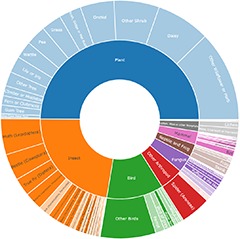Moths (Lepidoptera)
Useful references:
- CSIRO's Australian National Insect Collection (ANIC) - Australian Moths Online
- Don Herbison-Evans web pages:
In the notes provided about individual species, semi-technical terms are sometimes used. They are briely explained below.
Labial palpi. These are paired appendages extending from the lower part of the head, on either side of the proboscis. They provide important information about the family of the moth.
Parts of a moth’s wing:
Costa: The leading edge of the wing
Inner margin: The trailing edge of the wing
Termen: The outer margin of the wing, connecting the costa to the inner margin
Apex: The leading tip of the wing, where the costa and termen meet
Tornus: The trailing corner of the wing, where the termen and inner margin meet
Cilia. Long hairy scales along an edge of the wing
Announcements
Earlier this week, NatureMapr suffered a large scale denial of service style attack, causing a sustained outage over several days.It is important to stress that sensitive data was not at risk at any s...
Continue reading
Change to user profile page structure
Sensitive data handling improvements
Discussion
Elachista flammula
Elachista flammula
Significant sightings
- Iulactis semifusca
- Limnaecia phragmitella at Melba, ACT
- Opogona cleonyma at Melba, ACT
- Sclerocris chalcoxantha at Tharwa, ACT
- Synemon plana at Murrumbateman, NSW
- Synemon plana at Canberra, ACT
- Synemon plana at Lyneham, ACT
- Synemon plana at Yarralumla, ACT
- Undescribed species Boarmiini tribe at Bulli, NSW
- Undescribed species Boarmiini tribe at Bulli, NSW
Recent activity
Top contributors
- kasiaaus 5.4K
- jb2602 2.7K
- WendyEM 1.9K
- AlisonMilton 1.6K
- PJH123 1.6K
- ConBoekel 1.5K
- Hejor1 1.2K
- Bron 1.2K
- SteveBorkowskis 1.1K
- GlennCocking 1K
Top moderators
- donhe 15.6K
- ibaird 13.6K
- GlennCocking 3.4K
- DianneClarke 1.4K
- MichaelMulvaney 616
- MichaelBedingfield 172
- JulieMorgan 165
- kasiaaus 107
- KimPullen 97
- jb2602 60















































































































